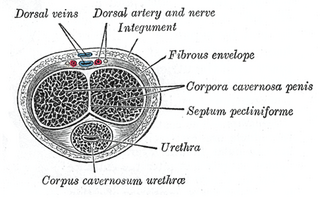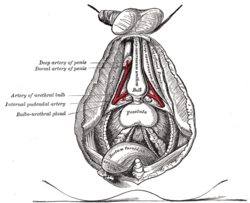
The corpus spongiosum is the mass of spongy tissue surrounding the male urethra within the penis. It is also called the corpus cavernosum urethrae in older texts.

The bulbospongiosus muscle is one of the superficial muscles of the perineum. It has a slightly different origin, insertion and function in males and females. In males, it covers the bulb of the penis. In females, it covers the vestibular bulb.

The internal pudendal artery is one of the three pudendal arteries that branches off the internal iliac artery. It provides blood to the external genitalia.

In female anatomy, the vestibular bulbs, bulbs of the vestibule or clitoral bulbs are two elongated masses of erectile tissue typically described as being situated on either side of the vaginal opening. They are united to each other in front by a narrow median band. Some research indicates that they do not surround the vaginal opening, and are more closely related to the clitoris than to the vestibule.

The inferior rectal artery is an artery that supplies blood to the lower half of the anal canal.

The inferior mesenteric plexus is derived chiefly from the aortic plexus.

The membranous layer of the superficial fascia of the perineum is the deeper layer of the superficial perineal fascia. It is thin, aponeurotic in structure, and of considerable strength, serving to bind down the muscles of the root of the penis. Colles' fascia emerges from the perineal membrane, which divides the base of the penis from the prostate. Colles' fascia emerges from the inferior side of the perineal membrane and continues along the ventral (inferior) penis without covering the scrotum. It separates the skin and subcutaneous fat from the superficial perineal pouch.

The aorticorenal ganglion is composed of the superior mesenteric, renal, and inferior mesenteric ganglia. This is distinct from the celiac ganglia. However, they are part of the preaortic ganglia.

The posterior scrotal branches or posterior labial branches are two in number, medial and lateral. They are branches of the perineal nerve, which is itself a branch of the pudendal nerve. The pudendal nerve arises from spinal roots S2 through S4, travels through the pudendal canal on the fascia of the obturator internus muscle, and gives off the perineal nerve in the perineum. The major branch of the perineal nerve is the posterior scrotal/posterior labial.

The Inferior rectal nerves usually branch from the pudendal nerve but occasionally arises directly from the sacral plexus; they cross the ischiorectal fossa along with the inferior rectal artery and veins, toward the anal canal and the lower end of the rectum, and is distributed to the Sphincter ani externus and to the integument (skin) around the anus.

The Dorsal Artery of the Penis is a branch of the internal pudendal artery which ascends between the crus penis and the pubic symphysis, and, piercing the inferior fascia of the urogenital diaphragm, passes between the two layers of the suspensory ligament of the penis, and runs forward on the dorsum of the penis to the glans, where it divides into two branches, which supply the glans and prepuce. The dorsal arteries do give perforators to the corpora cavernosa, however their contribution to erectile function is inconsistent. Through retrograde flow they help supply the distal shaft skin. Additionally, they give branches to the circumflex arteries which supply the corpus spongiosum. The major clinical relevance is in the case of traumatic amputation of the penis, failure to perform re-anastomosis of the dorsal arteries leads to skin loss.

The dorsal nerve of the penis is the deepest division of the pudendal nerve; it accompanies the internal pudendal artery along the ramus of the ischium; it then runs forward along the margin of the inferior ramus of the pubis, between the superior and inferior layers of the fascia of the urogenital diaphragm.

The deep artery of the penis, one of the terminal branches of the internal pudendal, arises from that vessel while it is situated between the two fasciæ of the urogenital diaphragm.

The perineal membrane is an anatomical term for a fibrous membrane in the perineum. The term "inferior fascia of urogenital diaphragm", used in older texts, is considered equivalent to the perineal membrane.

The superficial perineal pouch is a compartment of the perineum.

The deep perineal pouch is the anatomic space enclosed in part by the perineum, and located superior to the perineal membrane.

The membranous urethra or intermediate part of male urethra is the shortest, least dilatable, and, with the exception of the urinary meatus, the narrowest part of the urethra.

The pelvic fasciae are the fascia of the pelvis and can be divided into:

Just before each crus of the penis meets its fellow, it presents a slight enlargement, which Georg Ludwig Kobelt named the bulb of the corpus cavernosum penis. The bulb of penis is also known as the urethral bulb.

The superior fascia of the urogenital diaphragm is continuous with the obturator fascia and stretches across the pubic arch.


















